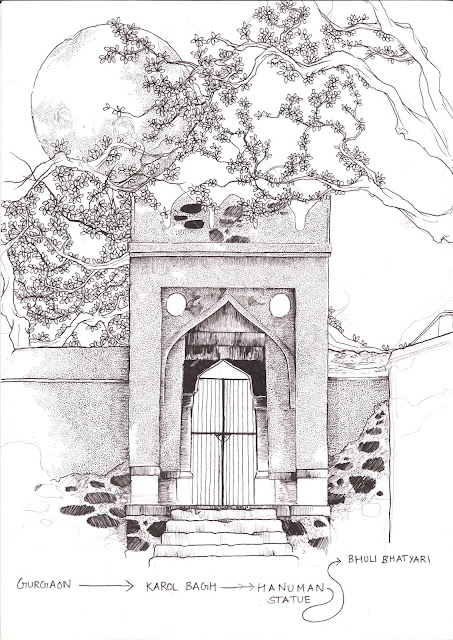SA Site Cover: The Bhuli Bhatyari ka Mahal by Siddhartha Iyer
THE BHULI BHATYARI KA MAHAL
An oddly disproportional and red Hanuman stands sternly,
ripping his chest open as Delhi wizzes by his feet. Many seem almost oblivious
to this grand and grotesque gesture. There is a meeting to get to, a date, an
assignment to submit a week after it was due, or in most cases just an air
conditioner to find and set up base in
front of. Behind the statue, a thin, unassuming road slithers past all the
chaos, ending at a place strikingly different from where it began. It ends in
the 14th century, at a now decrepit Tughlaq era hunting lodge.
The bhuli bhatyari ka mahal is conveniently tucked away
behind the hanuman statue in busy Karol Bagh. It is a spot like so many others
in the capital, where the ancient and the modern live cheek and jowl, and
hopefully will continue to do so for a long time to come. It faces a large DMNC
water tank, where on most occasions, the water turns a rancid green. Every few
minutes, the silence around gets interrupted by the metro, just in case you
forget that you still are in a city of over 25 million and counting. The
entrance to the lodge is a large arch, with only hints of the original red
sandstone peeking out from behind its newly ‘renovated’ walls. It opens up to a
narrow corridor, winding to the right and leading up into a large open-air courtyard.
Tiny rooms built into the surrounding walls were used
most probably as accommodation for those that came and hunted here. Nothing
inside them now suggests, that someone could have once rested comfortably in a
space so tiny. But maybe that’s just my tall person privilege speaking? What
would possibly have been a grand open courtyard, where members of the hunters convened,
gossiped, planned and found momentary refuge from the city outside, is now
barren and by most accounts even ‘haunted’.
To the north of the entrance, a flight of stairs lead up to a large open-air room where a small pool like structure takes up more than half of its space with channels running all the way down to the lower courtyard. Maybe around this shallow pool is where members of this club, debauched as they were, met, planned, fought and bonded over the sport of hunting beasts. In the unforgiving Delhi summers, this could have served as an oasis for the elite. A 14th century Delhi gymkhana anyone?
The Bhuli Bhatyari is not the original name given to this hunting lodge. Some suggest that the name came from a sufi saint called Bu Ali Bhaktiyari. What is clear, is that it was built under the reign of Feroz shah Tughlaq and is also quite similar to the Malcha mahal and Pir Ghaib, which popped up in the city around the same time. Its exterior walls stand surprisingly high for a structure built for recreational purposes. Beyond them on all three sides, lies the dense undergrowth of the Central ridge reserve forest.
The first time I was here, was just before nightfall after I snuck in past a sleeping guard who had conveniently forgotten to lock the entrance. The other time, I was unlucky enough to be caught climbing a tree
that had its branch drooping over one of the walls (the gate was shut this time)
But, one part of me still doesn’t
believe that it is indeed haunted, but the other part
maybe understands why someone might think it is. Its quite easy to get
carried away here. Even something as simple as a flight of stairs, become much
more than just a seemingly innocuous set of steps. You’re knowingly walking on
something that was walked on by thousands before you. In Delhi, and this ruin’s
case in particular, you’re probably setting your foot down at the same place
the emperor did. Or at least someone from the royal family, if you’re cynical.
Did he stumble? Did he fall and hurt himself on the knee? Did he rush down in
anger one day? Did he walk down them with one of his wives? Did he stop on the
very step you did to think about something like you did?
Maybe such thoughts only belong here, within these walls and are too fragile to be taken into the notorious old city outside. Maybe that's why so many visitors feel and experience things here that can't simply be put into words and maybe, even at the risk of contradicting myself, i'm one of them.












Beautiful description of this place.. would love to visit and experience it the way it has been described.
ReplyDeleteAmazing! Great job
ReplyDeleteGood one. Keep writing...
ReplyDeleteCommendable style of writing,so vivid and visually stimulating. Keep up the good work.
ReplyDelete